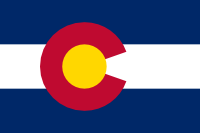 You can just tell that this flag came from the military. After the U.S. took control of the “Danish West Indies” in 1917, the new territorial governor installed in 1921 – a Navy real admiral – asked one of his officers to provide a flag. The captain picked a guy who drew a simplified version of the U.S. coat of arms, and in a flash of inspiration, added the letters V and I. To this day, no one knows what the letters stand for… the Roman number 6, maybe? It’s a total mystery.
You can just tell that this flag came from the military. After the U.S. took control of the “Danish West Indies” in 1917, the new territorial governor installed in 1921 – a Navy real admiral – asked one of his officers to provide a flag. The captain picked a guy who drew a simplified version of the U.S. coat of arms, and in a flash of inspiration, added the letters V and I. To this day, no one knows what the letters stand for… the Roman number 6, maybe? It’s a total mystery.
And it’s on a plain white field, so you can’t even read it as a flag if it’s on a white background.
There is literally nothing good to work with here.
 Thank God for the Danes, then. They had a flag of sorts for the colony. It consisted of their own flag in the canton, which we obviously can’t keep, and… a field of light blue. Not much, but it’s something.
Thank God for the Danes, then. They had a flag of sorts for the colony. It consisted of their own flag in the canton, which we obviously can’t keep, and… a field of light blue. Not much, but it’s something.

Instead of stuffing a red flag with a white cross in the canton, how about putting a diagonal field of red with a white border in the same corner? Tweak the blue a little bit to better represent the Caribbean Sea, and we’re done.

 Colorado’s flag is pretty good: a fairly classical stripes-of-color design with a central thingy to give it some individual character… and that thingy isn’t their damn state seal.
Colorado’s flag is pretty good: a fairly classical stripes-of-color design with a central thingy to give it some individual character… and that thingy isn’t their damn state seal.